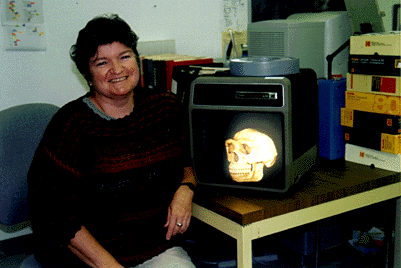![[Currents header graphic]](/homeart/currents_header.gif)
![[Currents header graphic]](/homeart/currents_header.gif)
August 18, 1997

|
|
Diane Gifford-Gonzalez with slide of plaster cast of a 'Peking Man' skull
|
One of the most impressive archaeological discoveries of the century threatens to fade from memory unless a grassroots effort led by UCSC anthropology professor Diane Gifford-Gonzalez to preserve volumes of notes and photographs gets under way quickly.
The famous 'Peking Man' excavation began in 1927 and led to the discovery in 1929 of early human remains at a site about 40 miles southwest of Beijing. Ultimately, the 12-year effort yielded remains of more than 40 individuals dating back 250,000 to 500,000 years. For nearly 60 years, the site held the distinction of producing the greatest number of fossil hominids ever found in one place.
Remarkably, all that remains of the multinational excavation are reams of notes, correspondence, and 2,000 photographs and negatives. The fossils were lost in 1939 following the Japanese invasion of China. American Marines who'd been called on to escort the precious remains to the American Museum of Natural History were captured by Japanese soldiers, and the fossils were never seen again.
The tragic loss sparked countless rumors, but Gifford-Gonzalez suspects that ignorance was responsible for the loss. "I suspect that the Japanese soldiers didn't know what they had and just thought the remains were a bunch of misshapen hunks of stone," she said.
Thankfully for archaeologists, the documents have been safeguarded by a dedicated Chinese paleoanthropologist named Jia Lanpo. Gifford-Gonzalez and colleague Dennis Etler, a paleoanthropologist at UC Berkeley's Laboratory for Human Evolutionary Studies, have spearheaded an informal effort to raise funds to preserve the records.
Jia was a graduate student in his early 20s when he was appointed interim overseer of the dig in 1929--shortly before the discovery of the first skull. A meticulous record keeper, he has preserved the valuable documents "through all the vicissitudes of 20th-century Chinese history," said Gifford-Gonzalez.
During the Cultural Revolution when entire libraries were destroyed, Jia moved the records from the Institute of Vertebrate Paleontology and Paleoanthropology in Beijing to his home, where he was able to keep people from invading his personal library and destroying it, said Gifford-Gonzalez.
"Through this tumultuous century he has preserved these precious records--made doubly precious because of the loss of the originals," said Gifford-Gonzalez.
Gifford-Gonzalez saw Jia's documents in 1992 when she coordinated two workshops for Chinese archaeologists (see October 1992 Currents). Etler became aware of the records at about the same time and began his own fund-raising efforts; he and Gifford-Gonzalez teamed up in 1996.
"I learned about this collection in 1992, when Jia showed it to me," said Gifford-Gonzalez. "He's been showing the records to people, and nobody's been doing anything. They really don't have the facilities or expertise in China to preserve these records."
Now 90, Jia is determined to see the records adequately conserved. "I believe Professor Jia aims to stay alive so he can get this done," said Gifford-Gonzalez. "He's getting quite frail now, and he's losing his vision, but he's still mentally sharp." Gifford-Gonzalez described Jia as "a man of very strong opinions. He's ready and willing to talk about these documents and the history."
For more than a year, Gifford-Gonzalez and Etler have been raising the funds to send Etler--who speaks Chinese fluently--and a photo conservator to Jia to record his oral history of events and to assess the scope of the conservation effort.
"It's the hardest fund-raising I've ever done because it doesn't fit into anyone's purview," said Gifford-Gonzalez, who has just recently secured final funding from the Wenner-Gren Foundation for Anthropological Research, the LSB Leakey Foundation, and National Geographic. Etler and the conservator will travel to China this fall.
"I feel very strongly that archaeological archives are terribly important," said Gifford-Gonzalez, who anticipates applying to the National Science Foundation for support to do the actual preservation work. Ultimately, her goal is to stabilize the original documents for preservation in China; produce one set of facsimiles that will be made available to researchers in China; and generate a second set to be held at the American Museum of Natural History--where the prehistoric remains were bound in 1939--for use by researchers.
"This is a world-class site, and these records are invaluable, not just from the historical perspective but from a research point of view, as well," she said. "They could answer questions about these remains that we haven't been able to answer yet. I'm vastly relieved and incredibly happy to have taken this first step."